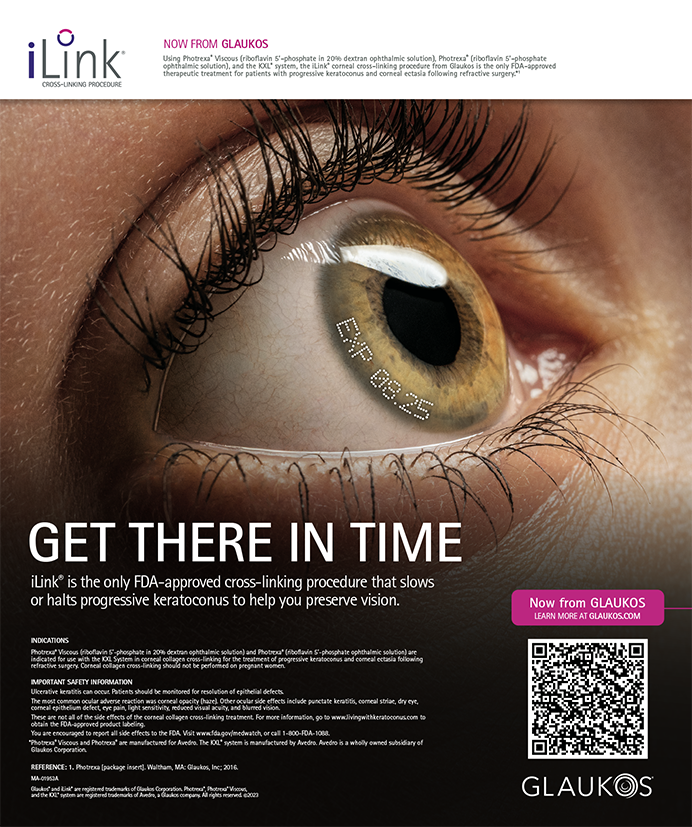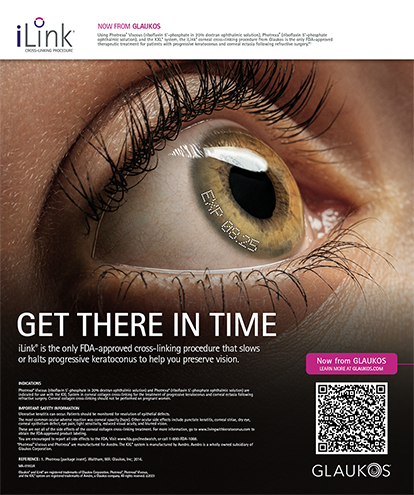In the conventional method of staining the capsule with indocyanine green (ICG), the powdered dye is diluted in BSS Plus (Alcon Laboratories, Inc., Fort Worth, TX) and provides only a faint stain. Dissolving ICG into a cohesive viscoelastic agent (a solution called visco-ICG) achieves deeper, more uniform staining. If ICG dissolved in BSS Plus resembles an ink, then visco-ICG is like paint. To apply visco-ICG most effectively and safely, the corneal endothelium should be protected by the modified soft shell technique called soft shell stain. The lens capsule stained by this method will never become fragile.
HOW TO MAKE VISCO-ICGOne milliliter of sterile distilled water is injected into a bottle of ICG, which contains 25mg of ICG powder (Diagnogreen; Daiichi Pharmaceutical Co. Ltd., Tokyo, Japan). Shaking the bottle for a few minutes dissolves the powder completely. After aspirating all of the solution into a 5-mL syringe, I add one vial (0.7mL) of Provisc (Alcon Laboratories, Inc.) into the syringe and shake it vigorously for another few minutes. A small amount of air in the syringe will facilitate the mixing of the ICG solution with the viscoelastic. Once aspirated into a sterile 2.5-mL syringe, the mixture may be prepared for use with a visco-ICG cannula (AE-7272; American Surgical Instruments Corporation, Westmont, IL). One vial of visco-ICG solution can be used for several cases.
SOFT SHELL STAINAfter injecting a small amount of Viscoat (Alcon Laboratories, Inc.) into the front of the anterior chamber (Figure 1), I inject Provisc under the Viscoat so that the latter may spread uniformly on the corneal endothelial surface. To completely coat the endothelium with Viscoat, the amount of Provisc must be sufficient to flow out of the incision (Figure 2). I then remove the Provisc with I/A to make a space for the visco-ICG (Figure 3). The dispersive Viscoat will remain on the cornea and iris, where it will form a transparent, soft shell. I apply the visco-ICG to the capsular surface by means of the visco-ICG cannula (Figure 4). Because this instrument has an oval port on the inferior side of its curved tip, I can paint a small amount of the visco-ICG on the lens' surface. With Viscoat protecting the cornea, I am able to fill the anterior chamber with visco-ICG and then immediately wash the chamber with I/A (Figure 5). If any part of the capsule is unstained, I can apply additional visco-ICG focally using the procedure just described. It is important not to inject too much visco-ICG under the iris blindly, or the vitreous body may be stained for a few days. Next, I fill the anterior chamber with Viscoat (Figure 6) and perform the capsulorhexis (Figure 7).
TIPS FOR A SUCCESSFUL CAPSULORHEXISDespite the advantage of a deeply stained capsule, successfully executing the capsulorhexis requires a careful approach. In cases of white, intumescent cataract in which the lenticular cortex has liquefied, it is important to reduce the intralenticular and vitreous pressures by the intravenous administration of a hyperosmotic agent such as mannitol or glycerin 1 hour before surgery. One should also be certain to fill the anterior chamber sufficiently with Viscoat before starting the capsulorhexis so that the lens' surface is pushed flat or concave. This viscoelastic is unlikely to flow out of the incision during the procedure.
Positive pressure in the anterior chamber will augment one's control of the capsulorhexis' edge. Before starting the capsulorhexis, I puncture the capsule and wait for a moment until liquefied cortex leaks through the hole. Reducing the intralenticular pressure makes it easier to perform the capsulorhexis. I strongly advise against making a large capsulorhexis initially, because its edge will often tear to the equator. If the initial capsulorhexis was too small, it will be easy to enlarge after removing the liquefied cortex. The ideal capsulorhexis is a little smaller than the size of the IOL's optic and is located centrally so that the optical edge is uniformly covered by the capsulorhexis.
CONCLUSIONI have used this technique for more than 5 years in nearly 1,000 cases. My success rate of a complete capsulorhexis in cases of white, mature cataracts is greater than 99%. I have never experienced any complications. Capsular staining is helpful not only for a white, mature cataract but also for a dense nucleus with a poor retro-reflex of the microscope illumination. The use of visco-ICG can also be beneficial in cases of corneal opacity.
Takayuki Akahoshi, MD, is Director of Ophthalmology at the Mitsui Memorial Hospital in Tokyo. He states that he holds no financial interest in any of the products or companies mentioned herein. Dr. Akahoshi may be reached at +81 3 3862 9111; eye@bg.wakwak.com.


